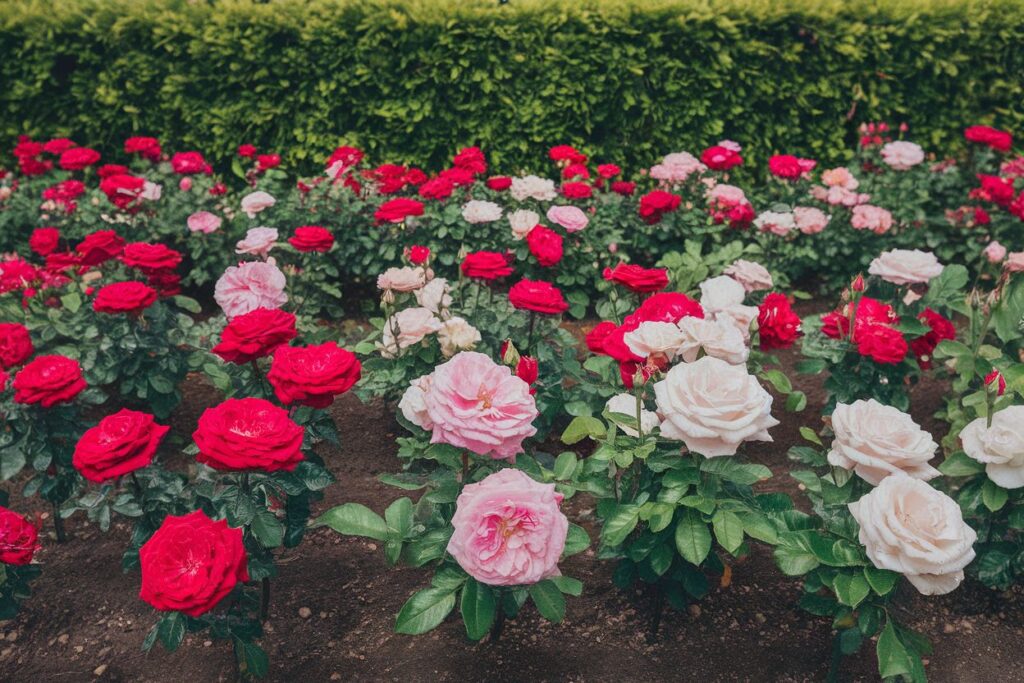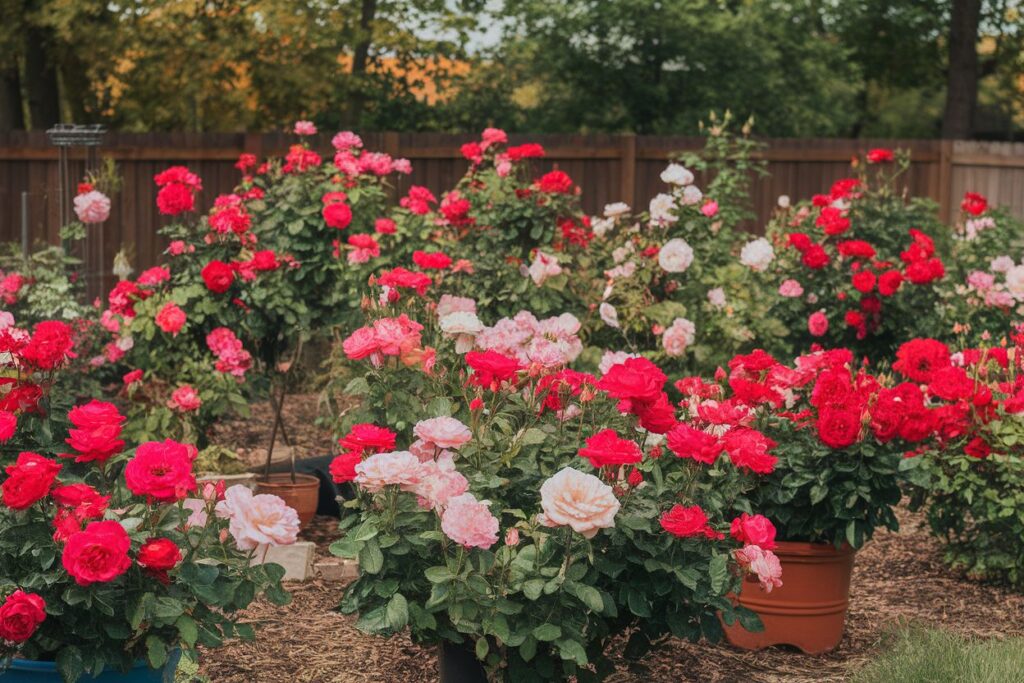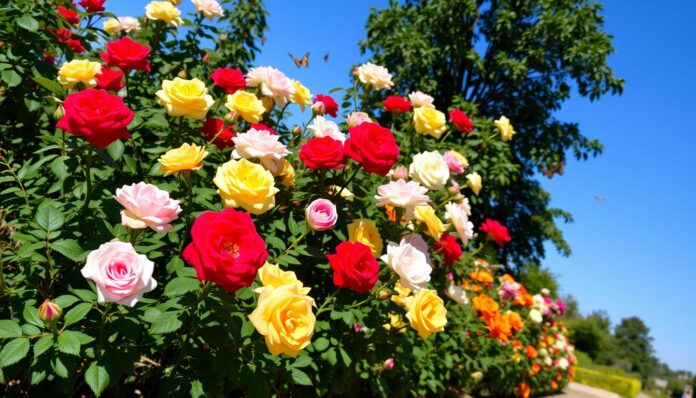Growing roses in gardening zone 8 is exciting for garden lovers. This area has mild winters and long growing seasons. It’s perfect for roses with the right care and knowledge of the local weather.
The USDA hardiness zones help gardeners pick the right plants for their area. Zone 8 has winters between 10 and 20 degrees Fahrenheit. This makes it great for many rose types and varieties.
Choosing the right roses for Zone 8 is key. Weather, rain, and seasons affect rose health. Knowing this helps gardeners grow beautiful roses.
When growing roses in Zone 8, pick varieties that resist diseases. Make sure the soil is right and keep up with care. Local tips can also help with growing roses in this zone.
Understanding Zone 8 Climate Characteristics
Rose gardeners in Zone 8 have a great climate for growing roses. The climate is perfect for roses, with the right temperatures and rain. This makes it a great place for garden lovers.
Average Annual Temperature Range
The Zone 8 climate is just right for roses. It gets cold enough to keep roses healthy but not too cold. This lets gardeners grow many types of roses.
Frost Dates and Growing Season Length
Gardeners in Zone 8 have a long growing season. Frost dates are from early March to late November. This means eight to nine months of growing roses.
“In Zone 8, roses have the luxury of time – a longer growing season means more opportunities for beautiful blooms.” – Professional Rose Cultivator
Rainfall and Humidity Patterns
Rainfall in Zone 8 is key for growing roses. The area gets enough rain to help roses grow well. But not so much that it causes diseases. Knowing about rain helps gardeners water and choose plants wisely.
Best Rose Varieties for Zone 8 Gardens

Choosing the right roses for Zone 8 can make your garden vibrant and strong. Roses that handle heat well are key for gardeners in this area. Summers here can be hot and unpredictable.
“The key to a successful rose garden in Zone 8 is choosing varieties that can withstand high temperatures and resist common diseases,” says renowned garden expert Sarah Peterson.
Many disease-resistant roses do great in Zone 8. The Knockout Rose series is a top pick. They have beautiful blooms and last a long time. These roses love full sun and can take the heat with little care.
The Belinda’s Dream rose is also a great choice for classic beauty. It has big pink flowers and can handle the heat well. It’s perfect for Zone 8’s tough growing conditions.
Other great Zone 8 roses include the Iceberg White Rose and the Coral Drift Rose. They bring elegance and color to your garden. These roses not only survive but thrive in Zone 8’s warm climate.
When picking roses, choose ones that can handle the heat and diseases of Zone 8. This will help your garden look beautiful and stay healthy.
Optimal Growing Conditions in gardening zone 8
Rose lovers in Zone 8 have special challenges and chances. Knowing the right growing conditions can make your rose garden lively and healthy.
Soil Requirements and Preparation
To grow roses well, start with the right soil. Roses love soil that drains well and is slightly acidic, with a pH of 6.0 to 6.5. Before planting, add organic compost to the soil. This improves nutrients and helps with drainage.
Also, mix in aged manure or high-quality garden soil. This gives your roses the minerals they need.
Sunlight and Shade Considerations
Choosing the right sunlight for roses in Zone 8 is key. Most roses need six to eight hours of direct sunlight a day. But, they should also get some shade from the intense afternoon sun.
Getting morning sun helps roses grow strong and bloom brightly.
Water and Drainage Needs
Good drainage is vital for rose health in Zone 8’s changing weather. Water roses deeply but not too often. Let the soil dry a bit between waterings.
Build raised beds or mounded areas to stop water from pooling. Mulching around the base of roses keeps moisture in and prevents root rot.
Seasonal Rose Care and Maintenance
For gardeners in Zone 8, making a detailed rose care calendar is key. The mild weather lets you grow roses all year. Knowing how to care for them seasonally helps them bloom beautifully.
Spring is when you should do seasonal pruning. Cut off dead or damaged branches after the last frost, usually in late February or early March. This step helps new growth and gets roses ready for the growing season. It’s also time to fertilize with balanced nutrients for strong growth.
In summer, you need to keep up the care. Remove spent blooms to keep roses flowering and prevent disease. Water deeply when it’s hot, focusing on the roots. Mulching keeps the soil moist and cool in Zone 8’s summer.
As fall comes, cut back on fertilizing and let plants slow down. In Zone 8, winter protection is minimal. Just a light mulch around the base is enough to protect against frost. Use breathable frost cloths for sensitive varieties during cold snaps.
Having a good rose care calendar keeps your plants looking great all year in Zone 8. Adjust your care based on your area’s climate and the needs of your roses.
Common Challenges and Solutions for Zone 8 Rose Growing

Growing roses in Zone 8 comes with its own set of challenges. Gardeners need to carefully plan to keep their rose gardens healthy and vibrant. Knowing the common issues helps protect these beautiful plants from many threats.
Disease Prevention and Treatment
Rose diseases can ruin a garden if not treated early. In Zone 8, fungal problems like black spot and powdery mildew are common. To prevent these, ensure good air flow, avoid overhead watering, and choose disease-resistant roses.
Regularly check your plants for signs of disease. Use copper-based fungicides to fight off any outbreaks.
Pest Management Strategies
Controlling pests is key to protecting roses from insects. Aphids and spider mites often attack rose gardens in Zone 8. To fight them, introduce beneficial insects like ladybugs and lacewings.
Neem oil and insecticidal soaps are good, eco-friendly options for pest control. They help keep pests away without harming other beneficial garden creatures.
Weather-Related Challenges
Heat stress is a big problem for roses in Zone 8’s hot summers. Mulching helps keep the soil cool and moist. Also, provide shade in the afternoon and water regularly to prevent damage from heat.
When it gets cold, cover your roses with frost cloths. Move container plants to safe places to protect them from winter damage.
Pruning and Training Techniques for Healthy Growth
Learning how to prune roses is key for keeping them healthy in Zone 8. Pruning helps shape the plant, boosts growth, and increases blooms. It’s important to cut out dead, damaged, or crossing branches to improve air flow and plant health.
Training climbing roses requires careful planning. Use trellises, arbors, and stakes to guide the rose canes. Shaping rose bushes means removing weak stems and creating an open structure for sunlight and air.
Deadheading is vital for rose care. It encourages more blooms and stops the plant from wasting energy on seeds. In Zone 8, deadheading is especially important to keep roses blooming all spring and summer.
Pruning at the right time is crucial. In Zone 8, prune in late winter or early spring, just before new growth starts. Use sharp, clean tools and make cuts at a 45-degree angle to prevent disease and promote healing.
Final Thoughts
Growing roses in Zone 8 is possible with dedication and effort. This zone’s climate offers both challenges and chances for beautiful gardens. By choosing the right roses and following Zone 8 tips, gardens can bloom with color.
Maintaining a rose garden in Zone 8 needs a careful plan. It’s important to know about local temperatures, soil, and seasons. By picking the right plants and preparing the soil well, gardens can flourish.
Seeing rose growing as a learning journey is key. Every season offers new chances to improve gardening skills. With patience and knowledge, a stunning rose garden can become a source of joy all year.
The path to a successful rose garden in Zone 8 is rewarding. By using the advice from this article, gardeners can make their outdoor spaces beautiful. Enjoying the beauty of well-cared-for roses is a great reward.











